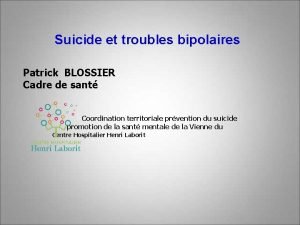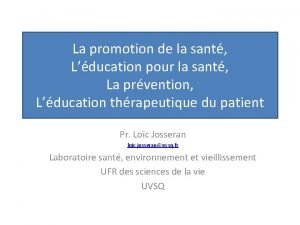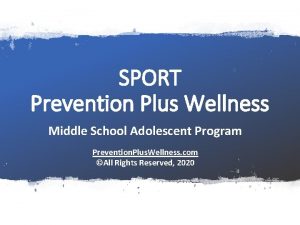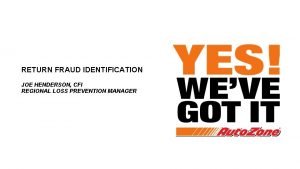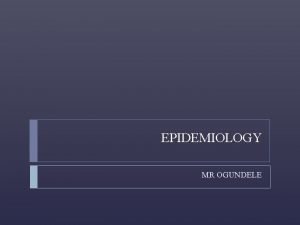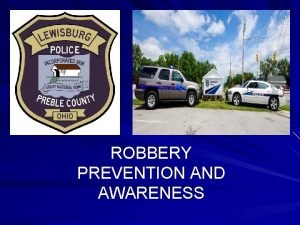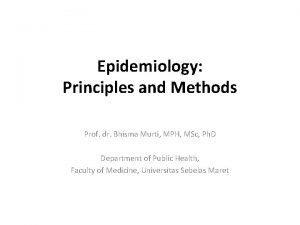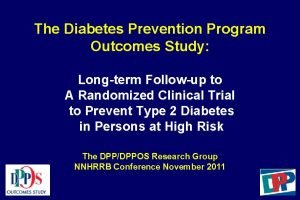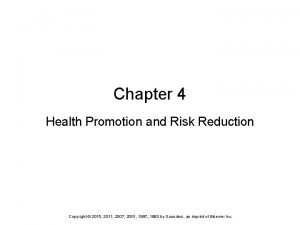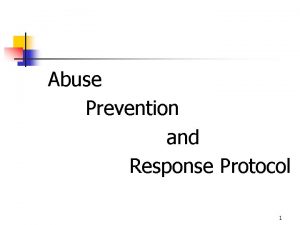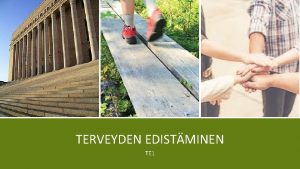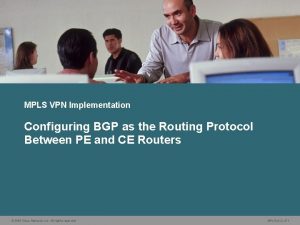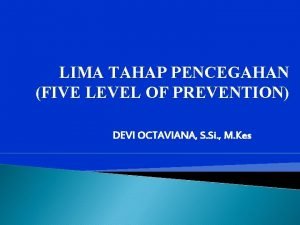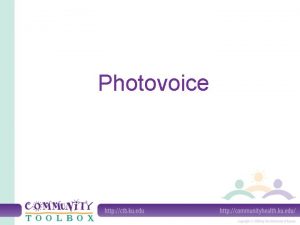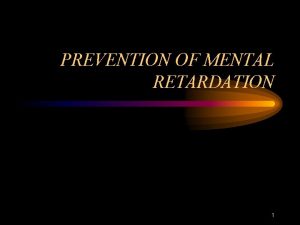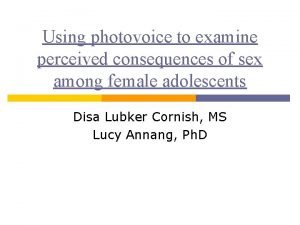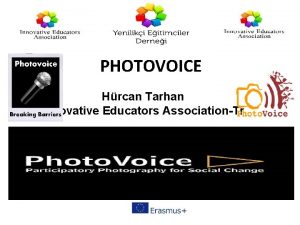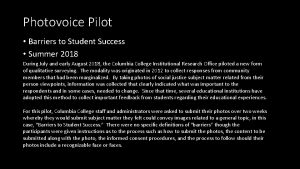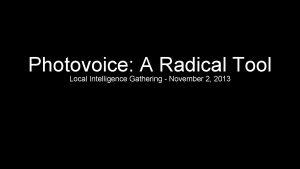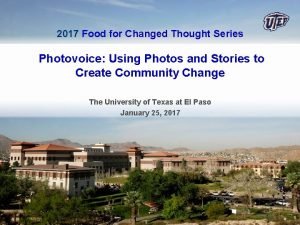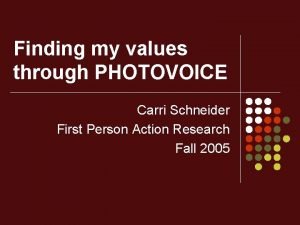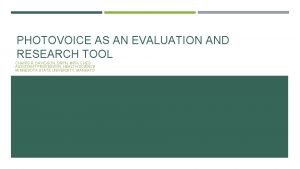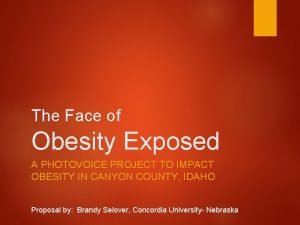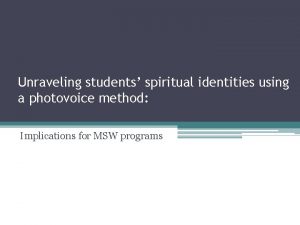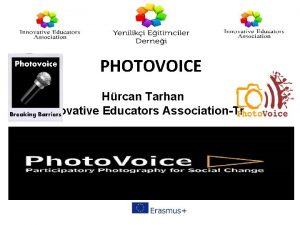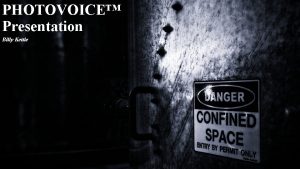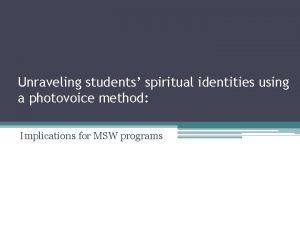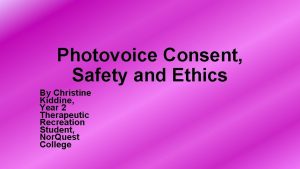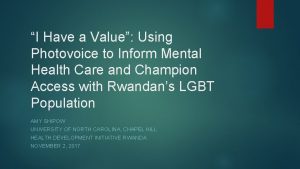Photovoice as Prevention What is Photovoice Photovoice is





















- Slides: 21

Photovoice as Prevention

What is Photovoice? Photovoice is an qualitative research method that gives participants an opportunity to capture conditions in their community through photography.

Goals of Photovoice Source: Rutgers International

Photovoice as Prevention Photovoice is an innovative prevention activity because it focuses on building protective factors that mitigate risk, thereby increasing the health and well-being of participating youth.

Protective Factors Photovoice builds protective factors by: 1. Providing a creative outlet to process participants’ feelings, building resilience 2. Fostering positive youth-adult relationships 3. Developing a skill 4. Creating connections for youth in their community 5. Empowering participants to share their perspective with the greater community 6. Providing opportunities for advocacy

Photovoice Method: Developing Research Focus I ask the following questions of the students: 1. What makes up your world as an individual? 2. What relationships are important to you? 3. Think about what makes up your community (communities); do you feel that you are a part of a community at school, in your workplace, in your neighborhood(s), in your town? Is community defined by shared physical space, and/or shared attributes, common beliefs, and strong connections?

Photovoice Method: Developing Research Focus Questions, cont. : 4. What societal factors impact your community? For example, how do health, economic, educational, and social influences impact your community? 5. What is positive about your community? What is negative? 6. What do you want people to know about your community? What can people learn from you?

Photovoice Method: Sharing the Social Ecological Framework for Prevention Source: Oregon Department of Human Services-Health Services

Photovoice Method: Photography 101 1. Introduction to digital photography 2. Introduction to photography ethics 3. Introduction to photography as a tool for social change

Photovoice Method: Brainstorm Locations to take Photographs

Photovoice Method: Take Pictures

Photovoice Method: Final Project • I encourage the students to think about how they would like to show their work. • We select photos to focus on and then sit down to have facilitated discussions to create captions.

Photovoice Method: Creating Captions To create captions, I ask the following questions of the students: 1. What is happening in the picture? 2. What is the photograph’s significance to the student? 3. What can people in the community learn from the photograph?

Photovoice Method: Displaying Photographs

Photovoice Method: Displaying Photographs

“I have a lot of memories in that house because my sister and my boyfriend used to live there. I would hang out there and play video games there. So it meant something to me. The thing that crushed me the most is that my nana died and she had these glass apple jars that she put things in. My sister had them. When the house burned down, they weren’t there. People can learn from this picture to be aware of their surroundings. ” – Student at Alternative Pathways Center in Biddeford

When I think of power lines the word that comes to mind is connection. Connection is important and it’s pretty vital in community. -Student at the Alternative Pathways Center in Biddeford

“Taking a rest at Goose Rocks Beach after longboarding. Maybe we should open that skate park. ” -Student in the Alternative Education program at Kennebunk High School

“This picture is significant because it shows the distance people put between themselves and people who are addicted. People in our community can learn from this picture that just because the road you’re walking on is lonely now, doesn’t mean it will be around the corner. ” -Student in the Alternative Education Program at Kennebunk High School

Resources • YPR (Youth-led Participatory Action Research) Hub: http: //yparhub. berkeley. edu/investigate/identifyingphotographing-assets-using-showed-process/ • Rutgers International Photovoice Manual: https: //www. rutgers. international/sites/rutgersorg/files/ PDF/Photo. Voice_Manual_18042016. pdf • Hamilton Community Foundation Photovoice Manual: https: //www. naccho. org/uploads/downloadableresources/Programs/Public-Health. Infrastructure/Photovoice-Manual. pdf

Contact Information Nina Macgowan Coordinator, Coastal Healthy Communities Coalition Email: nbennett@une. edu Office Phone: (207) 602 -3504 Please be sure to check out our social media sites to see our Photovoice updates!!!
 Primary prevention secondary prevention tertiary prevention
Primary prevention secondary prevention tertiary prevention How to make a photovoice
How to make a photovoice Caroline c wang
Caroline c wang What is photovoice
What is photovoice 5 levels of prevention leavell and clark
5 levels of prevention leavell and clark Bipolaire suicide
Bipolaire suicide San francisco fire prevention
San francisco fire prevention Prévention quaternaire
Prévention quaternaire Sport prevention plus wellness
Sport prevention plus wellness Cfi loss prevention
Cfi loss prevention Primordial prevention
Primordial prevention Prévention dso
Prévention dso Bank robbery prevention
Bank robbery prevention Bhisma murti
Bhisma murti Diabetes prevention program outcomes study
Diabetes prevention program outcomes study Mad acronym suicide prevention
Mad acronym suicide prevention Health promotion and levels of disease prevention
Health promotion and levels of disease prevention Glencoe health chapter 3
Glencoe health chapter 3 Abuse prevention and response protocol
Abuse prevention and response protocol Promootio terveys
Promootio terveys Bgp loop prevention
Bgp loop prevention Five level of prevention
Five level of prevention





